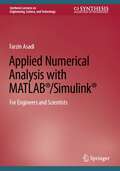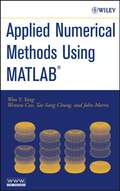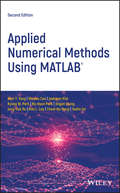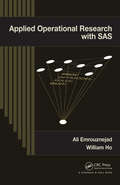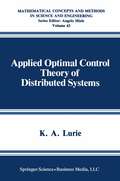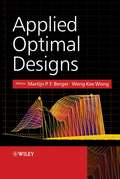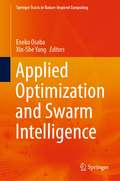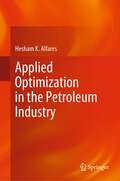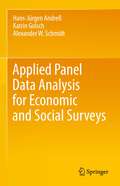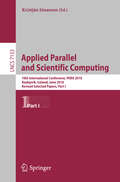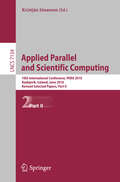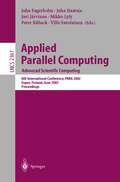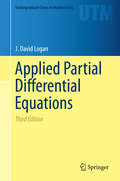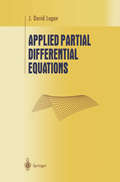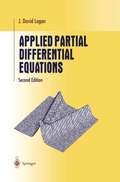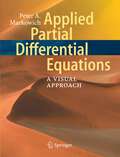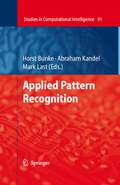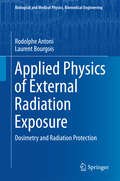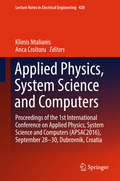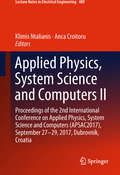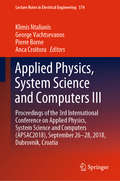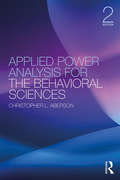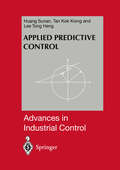- Table View
- List View
Applied Numerical Analysis with MATLAB®/Simulink®: For Engineers and Scientists (Synthesis Lectures on Engineering, Science, and Technology)
by Farzin AsadiThis textbook provides a compact but comprehensive treatment that guides students through applied numerical analysis, using MATLAB®/Simulink®. Ideal as a hands-on source for courses in Numerical Analysis, this text focuses on solving problems using market-standard software, corresponding to all key concepts covered in the classroom. The author uses his extensive classroom experience to guide students toward deeper understanding of key concepts, while they gain facility with software they will need to master for later studies and practical use in their engineering careers.
Applied Numerical Methods Using MATLAB
by Won Y. Yang Wenwu Cao Tae-Sang Chung John MorrisIn recent years, with the introduction of new media products, there has been a shift in the use of programming languages from FORTRAN or C to MATLAB for implementing numerical methods. This book makes use of the powerful MATLAB software to avoid complex derivations, and to teach the fundamental concepts using the software to solve practical problems. Over the years, many textbooks have been written on the subject of numerical methods. Based on their course experience, the authors use a more practical approach and link every method to real engineering and/or science problems. The main benefit is that engineers don't have to know the mathematical theory in order to apply the numerical methods for solving their real-life problems. An Instructor's Manual presenting detailed solutions to all the problems in the book is available online.
Applied Numerical Methods Using MATLAB
by Won Y. Yang Wenwu Cao Jaekwon Kim Kyung W. Park Ho-Hyun Park Jingon Joung Jong-Suk Ro Han L. Lee Cheol-Ho Hong Taeho ImThis new edition provides an updated approach for students, engineers, and researchers to apply numerical methods for solving problems using MATLAB® This accessible book makes use of MATLAB® software to teach the fundamental concepts for applying numerical methods to solve practical engineering and/or science problems. It presents programs in a complete form so that readers can run them instantly with no programming skill, allowing them to focus on understanding the mathematical manipulation process and making interpretations of the results. Applied Numerical Methods Using MATLAB®, Second Edition begins with an introduction to MATLAB usage and computational errors, covering everything from input/output of data, to various kinds of computing errors, and on to parameter sharing and passing, and more. The system of linear equations is covered next, followed by a chapter on the interpolation by Lagrange polynomial. The next sections look at interpolation and curve fitting, nonlinear equations, numerical differentiation/integration, ordinary differential equations, and optimization. Numerous methods such as the Simpson, Euler, Heun, Runge-kutta, Golden Search, Nelder-Mead, and more are all covered in those chapters. The eighth chapter provides readers with matrices and Eigenvalues and Eigenvectors. The book finishes with a complete overview of differential equations. Provides examples and problems of solving electronic circuits and neural networks Includes new sections on adaptive filters, recursive least-squares estimation, Bairstow's method for a polynomial equation, and more Explains Mixed Integer Linear Programing (MILP) and DOA (Direction of Arrival) estimation with eigenvectors Aimed at students who do not like and/or do not have time to derive and prove mathematical results Applied Numerical Methods Using MATLAB®, Second Edition is an excellent text for students who wish to develop their problem-solving capability without being involved in details about the MATLAB codes. It will also be useful to those who want to delve deeper into understanding underlying algorithms and equations.
Applied Numerical Methods Using MATLAB
by Won Y. Yang Wenwu Cao Jaekwon Kim Kyung W. Park Ho-Hyun Park Jingon Joung Jong-Suk Ro Han L. Lee Cheol-Ho Hong Taeho ImThis new edition provides an updated approach for students, engineers, and researchers to apply numerical methods for solving problems using MATLAB® This accessible book makes use of MATLAB® software to teach the fundamental concepts for applying numerical methods to solve practical engineering and/or science problems. It presents programs in a complete form so that readers can run them instantly with no programming skill, allowing them to focus on understanding the mathematical manipulation process and making interpretations of the results. Applied Numerical Methods Using MATLAB®, Second Edition begins with an introduction to MATLAB usage and computational errors, covering everything from input/output of data, to various kinds of computing errors, and on to parameter sharing and passing, and more. The system of linear equations is covered next, followed by a chapter on the interpolation by Lagrange polynomial. The next sections look at interpolation and curve fitting, nonlinear equations, numerical differentiation/integration, ordinary differential equations, and optimization. Numerous methods such as the Simpson, Euler, Heun, Runge-kutta, Golden Search, Nelder-Mead, and more are all covered in those chapters. The eighth chapter provides readers with matrices and Eigenvalues and Eigenvectors. The book finishes with a complete overview of differential equations. Provides examples and problems of solving electronic circuits and neural networks Includes new sections on adaptive filters, recursive least-squares estimation, Bairstow's method for a polynomial equation, and more Explains Mixed Integer Linear Programing (MILP) and DOA (Direction of Arrival) estimation with eigenvectors Aimed at students who do not like and/or do not have time to derive and prove mathematical results Applied Numerical Methods Using MATLAB®, Second Edition is an excellent text for students who wish to develop their problem-solving capability without being involved in details about the MATLAB codes. It will also be useful to those who want to delve deeper into understanding underlying algorithms and equations.
Applied Operational Research with SAS
by Ali Emrouznejad William HoUsing a wide range of operational research (OR) optimization examples, Applied Operational Research with SAS demonstrates how the OR procedures in SAS work. The book is one of the first to extensively cover the application of SAS procedures to OR problems, such as single criterion optimization, project management decisions, printed circuit board as
Applied Optimal Control Theory of Distributed Systems (Mathematical Concepts and Methods in Science and Engineering #43)
by K.A. LurieThis book represents an extended and substantially revised version of my earlierbook, Optimal Control in Problems ofMathematical Physics,originally published in Russian in 1975. About 60% of the text has been completely revised and major additions have been included which have produced a practically new text. My aim was to modernize the presentation but also to preserve the original results, some of which are little known to a Western reader. The idea of composites, which is the core of the modern theory of optimization, was initiated in the early seventies. The reader will find here its implementation in the problem of optimal conductivity distribution in an MHD-generatorchannel flow.Sincethen it has emergedinto an extensive theory which is undergoing a continuous development. The book does not pretend to be a textbook, neither does it offer a systematic presentation of the theory. Rather, it reflects a concept which I consider as fundamental in the modern approach to optimization of dis tributed systems. Bibliographical notes,though extensive, do not pretend to be exhaustive as well. My thanks are due to ProfessorJean-Louis Armand and ProfessorWolf Stadler whose friendly assistance in translating and polishing the text was so valuable. I am indebted to Mrs. Kathleen Durand and Mrs. Colleen Lewis for the hard job of typing large portions of the manuscript.
Applied Optimal Designs
by Martijn P. F. Berger Weng Kee WongThere is an increasing need to rein in the cost of scientific study without sacrificing accuracy in statistical inference. Optimal design is the judicious allocation of resources to achieve the objectives of studies using minimal cost via careful statistical planning. Researchers and practitioners in various fields of applied science are now beginning to recognize the advantages and potential of optimal experimental design. Applied Optimal Designs is the first book to catalogue the application of optimal design to real problems, documenting its widespread use across disciplines as diverse as drug development, education and ground water modelling. Includes contributions covering: Bayesian design for measuring cerebral blood-flow Optimal designs for biological models Computer adaptive testing Ground water modelling Epidemiological studies and pharmacological models Applied Optimal Designs bridges the gap between theory and practice, drawing together a selection of incisive articles from reputed collaborators. Broad in scope and inter-disciplinary in appeal, this book highlights the variety of opportunities available through the use of optimal design. The wide range of applications presented here should appeal to statisticians working with optimal designs, and to practitioners new to the theory and concepts involved.
Applied Optimization and Swarm Intelligence (Springer Tracts in Nature-Inspired Computing)
by Eneko Osaba Xin-She YangThis book gravitates on the prominent theories and recent developments of swarm intelligence methods, and their application in both synthetic and real-world optimization problems. The special interest will be placed in those algorithmic variants where biological processes observed in nature have underpinned the core operators underlying their search mechanisms. In other words, the book centers its attention on swarm intelligence and nature-inspired methods for efficient optimization and problem solving. The content of this book unleashes a great opportunity for researchers, lecturers and practitioners interested in swarm intelligence, optimization problems and artificial intelligence.
Applied Optimization in the Petroleum Industry
by Hesham K. AlfaresThe book addresses optimization in the petroleum industry from a practical, large-scale-application-oriented point of view. The models and techniques presented help to optimize the limited resources in the industry in order to maximize economic benefits, ensure operational safety, and reduce environmental impact. The book discusses several important real-life applications of optimization in the petroleum industry, ranging from the scheduling of personnel time to the blending of gasoline. It covers a wide spectrum of relevant activities, including drilling, producing, maintenance, and distribution. The text begins with an introductory overview of the petroleum industry and then of optimization models and techniques. The main body of the book details a variety of applications of optimization models and techniques within the petroleum industry.Applied Optimization in the Petroleum Industry helps readers to find effective optimization-based solutions to their own practical problems in a large and important industrial sector, still the main source of the world’s energy and the source of raw materials for a wide variety of industrial and consumer products.
Applied Panel Data Analysis for Economic and Social Surveys
by Hans-Jürgen Andreß Katrin Golsch Alexander W. SchmidtMany economic and social surveys are designed as panel studies, which provide important data for describing social changes and testing causal relations between social phenomena. This textbook shows how to manage, describe, and model these kinds of data. It presents models for continuous and categorical dependent variables, focusing either on the level of these variables at different points in time or on their change over time. It covers fixed and random effects models, models for change scores and event history models. All statistical methods are explained in an application-centered style using research examples from scholarly journals, which can be replicated by the reader through data provided on the accompanying website. As all models are compared to each other, it provides valuable assistance with choosing the right model in applied research. The textbook is directed at master and doctoral students as well as applied researchers in the social sciences, psychology, business administration and economics. Readers should be familiar with linear regression and have a good understanding of ordinary least squares estimation.
Applied Parallel and Scientific Computing: 10th International Conference, PARA 2010, Reykjavík, Iceland, June 6-9, 2010, Revised Selected Papers, Part I (Lecture Notes in Computer Science #7133)
by Kristján JónassonThe two volume set LNCS 7133 and LNCS 7134 constitutes the thoroughly refereed post-conference proceedings of the 10th International Conference on Applied Parallel and Scientific Computing, PARA 2010, held in Reykjavík, Iceland, in June 2010. These volumes contain three keynote lectures, 29 revised papers and 45 minisymposia presentations arranged on the following topics: cloud computing, HPC algorithms, HPC programming tools, HPC in meteorology, parallel numerical algorithms, parallel computing in physics, scientific computing tools, HPC software engineering, simulations of atomic scale systems, tools and environments for accelerator based computational biomedicine, GPU computing, high performance computing interval methods, real-time access and processing of large data sets, linear algebra algorithms and software for multicore and hybrid architectures in honor of Fred Gustavson on his 75th birthday, memory and multicore issues in scientific computing - theory and praxis, multicore algorithms and implementations for application problems, fast PDE solvers and a posteriori error estimates, and scalable tools for high performance computing.
Applied Parallel and Scientific Computing: 10th International Conference, PARA 2010, Reykjavík, Iceland, June 6-9, 2010, Revised Selected Papers, Part II (Lecture Notes in Computer Science #7134)
by Kristján JónassonThe two volume set LNCS 7133 and LNCS 7134 constitutes the thoroughly refereed post-conference proceedings of the 10th International Conference on Applied Parallel and Scientific Computing, PARA 2010, held in Reykjavík, Iceland, in June 2010. These volumes contain three keynote lectures, 29 revised papers and 45 minisymposia presentations arranged on the following topics: cloud computing, HPC algorithms, HPC programming tools, HPC in meteorology, parallel numerical algorithms, parallel computing in physics, scientific computing tools, HPC software engineering, simulations of atomic scale systems, tools and environments for accelerator based computational biomedicine, GPU computing, high performance computing interval methods, real-time access and processing of large data sets, linear algebra algorithms and software for multicore and hybrid architectures in honor of Fred Gustavson on his 75th birthday, memory and multicore issues in scientific computing - theory and praxis, multicore algorithms and implementations for application problems, fast PDE solvers and a posteriori error estimates, and scalable tools for high performance computing.
Applied Parallel Computing: 6th International Conference, PARA 2002, Espoo, Finland, June 15-18, 2002. Proceedings (Lecture Notes in Computer Science #2367)
by Juha Fagerholm Juha Haataja Jari Järvinen Mikko Lyly Peter Raback Ville SavolainenApplied Partial Differential Equations (Undergraduate Texts in Mathematics #89)
by J. David LoganThis textbook is for the standard, one-semester, junior-senior course that often goes by the title "Elementary Partial Differential Equations" or "Boundary Value Problems". The audience consists of students in mathematics, engineering, and the sciences. The topics include derivations of some of the standard models of mathematical physics and methods for solving those equations on unbounded and bounded domains, and applications of PDE's to biology. The text differs from other texts in its brevity; yet it provides coverage of the main topics usually studied in the standard course, as well as an introduction to using computer algebra packages to solve and understand partial differential equations.For the 3rd edition the section on numerical methods has been considerably expanded to reflect their central role in PDE's. A treatment of the finite element method has been included and the code for numerical calculations is now written for MATLAB. Nonetheless the brevity of the text has been maintained. To further aid the reader in mastering the material and using the book, the clarity of the exercises has been improved, more routine exercises have been included, and the entire text has been visually reformatted to improve readability.
Applied Partial Differential Equations (Undergraduate Texts in Mathematics)
by J. David LoganThis textbook is for the standard, one-semester, junior-senior course that often goes by the title "Elementary Partial Differential Equations" or "Boundary Value Problems;' The audience usually consists of stu dents in mathematics, engineering, and the physical sciences. The topics include derivations of some of the standard equations of mathemati cal physics (including the heat equation, the· wave equation, and the Laplace's equation) and methods for solving those equations on bounded and unbounded domains. Methods include eigenfunction expansions or separation of variables, and methods based on Fourier and Laplace transforms. Prerequisites include calculus and a post-calculus differential equations course. There are several excellent texts for this course, so one can legitimately ask why one would wish to write another. A survey of the content of the existing titles shows that their scope is broad and the analysis detailed; and they often exceed five hundred pages in length. These books gen erally have enough material for two, three, or even four semesters. Yet, many undergraduate courses are one-semester courses. The author has often felt that students become a little uncomfortable when an instructor jumps around in a long volume searching for the right topics, or only par tially covers some topics; but they are secure in completely mastering a short, well-defined introduction. This text was written to proVide a brief, one-semester introduction to partial differential equations.
Applied Partial Differential Equations (Undergraduate Texts in Mathematics #89)
by J. David LoganThis text is written for the standard, one-semester, undergraduate course in elementary partial differential equations. The topics include derivations of some of the standard equations of mathematical physics (including the heat equation, the wave equation, and Laplace's equation) and methods for solving those equations on bounded and unbounded domains. Methods include eigenfunction expansions, or separation of variables, and methods based on Fourier and Laplace transforms.
Applied Partial Differential Equations: A Visual Approach
by Peter MarkowichThis book presents topics of science and engineering which occur in nature or are part of daily life. It describes phenomena which are modelled by partial differential equations, relating to physical variables like mass, velocity and energy, etc. to their spatial and temporal variations. The author has chosen topics representing his career-long interests, including the flow of fluids and gases, granular flows, biological processes like pattern formation on animal skins, kinetics of rarified gases and semiconductor devices. Each topic is presented in its scientific or engineering context, followed by an introduction of applicable mathematical models in the form of partial differential equations.
Applied Pattern Recognition (Studies in Computational Intelligence #91)
by Horst Bunke Abraham Kandel Mark LastA sharp increase in the computing power of modern computers has triggered the development of powerful algorithms that can analyze complex patterns in large amounts of data within a short time period. Consequently, it has become possible to apply pattern recognition techniques to new tasks. The main goal of this book is to cover some of the latest application domains of pattern recognition while presenting novel techniques that have been developed or customized in those domains.
Applied Physics of External Radiation Exposure: Dosimetry and Radiation Protection (Biological and Medical Physics, Biomedical Engineering)
by Rodolphe Antoni Laurent BourgoisThis book describes the interaction of living matter with photons, neutrons, charged particles, electrons and ions. The authors are specialists in the field of radiation protection. The book synthesizes many years of experiments with external radiation exposure in the fields of dosimetry and radiation shielding in medical, industrial and research fields. It presents the basic physical concepts including dosimetry and offers a number of tools to be used by students, engineers and technicians to assess the radiological risk and the means to avoid them by calculating the appropriate shields. The theory of radiation interaction in matter is presented together with empirical formulas and abacus. Numerous numerical applications are treated to illustrate the different topics. The state of the art in radiation protection and dosimetry is presented in detail, especially in the field of simulation codes for external exposure to radiation, medical projects and advanced research. Moreover, important data spread in different up to date references are presented in this book. The book deals also with accelerators, X-rays facilities, sealed sources, dosimetry, Monte Carlo simulation and radiation regulation. Each chapter is split in two parts depending on the level of details the readers want to focus on. The first part, accessible to a large public, provides a lot of simple examples to help understanding the physics concepts under radiation external exposure. The second part, called “Additional Information” is not mandatory; it aims on explaining topics more deeply, often using mathematical formulations. The book treats fundamental radiometric and dosimetric quantities to describe the interaction in materials under the aspects of absorbed dose processes in tissues. Definitions and applications on limited and operational radiation protection quantities are given. An important aspect are practical engineering tools in industrial, medical and research domains. Source characterization and shielding design are addressed. Also more ”exotic” topics, such as ultra intense laser and new generation accelerators, are treated. The state of the art is presented to help the reader to work with the book in a self-consistent way. The basic knowledge necessary to apply Monte Carlo methods in the field of radiation protection and dosimetry for external radiation exposure is provided. Coverage of topics such as variance reduction, pseudo-random number generation and statistic estimators make the book useful even to experienced Monte Carlo practitioners. Solved problems help the reader to understand the Monte Carlo process. The book is meant to be used by researchers, engineers and medical physicist. It is also valuable to technicians and students.
Applied Physics, System Science and Computers: Proceedings of the 1st International Conference on Applied Physics, System Science and Computers (APSAC2016), September 28-30, Dubrovnik, Croatia (Lecture Notes in Electrical Engineering #428)
by Klimis Ntalianis Anca CroitoruThis book reports on advanced theories and methods in three related fields of research: applied physics, system science and computers. It is organized in two main parts, the first of which covers applied physics topics, including lasers and accelerators; condensed matter, soft matter and materials science; nanoscience and quantum engineering; atomic, molecular, optical and plasma physics; as well as nuclear and high-energy particle physics. It also addresses astrophysics, gravitation, earth and environmental science, as well as medical and biological physics. The second part focuses on advances in system science and computers, exploring automatic circuit control, power systems, computer communication, fluid mechanics, simulation and modeling, software engineering, data structures and applications of artificial intelligence among other areas. Offering a collection of contributions presented at the 1st International Conference on Applied Physics, System Science and Computers (APSAC 2016), the book bridges the gap between applied physics and electrical engineering. It not only to presents new methods, but also promotes collaborations between different communities working on related topics at the interface between physics and engineering, with a special focus on communication, data modeling and visualization, quantum information, applied mechanics as well as bio and geophysics.
Applied Physics, System Science and Computers II: Proceedings of the 2nd International Conference on Applied Physics, System Science and Computers (APSAC2017), September 27-29, 2017, Dubrovnik, Croatia (Lecture Notes in Electrical Engineering #489)
by Klimis Ntalianis Anca CroitoruThis book reports on advanced theories and methods in three related fields of research: applied physics, system science and computers. It is organized in three parts, the first of which covers applied physics topics, including lasers and accelerators; condensed matter, soft matter and materials science; nanoscience and quantum engineering; atomic, molecular, optical and plasma physics; as well as nuclear and high-energy particle physics. It also addresses astrophysics, gravitation, earth and environmental science, as well as medical and biological physics. The second and third parts focus on advances in computers and system science, respectively, and report on automatic circuit control, power systems, computer communication, fluid mechanics, simulation and modeling, software engineering, data structures and applications of artificial intelligence among other areas. Offering a collection of contributions presented at the 2nd International Conference on Applied Physics, System Science and Computers (APSAC), held in Dubrovnik, Croatia on September 27–29, 2017, the book bridges the gap between applied physics and electrical engineering. It not only to presents new methods, but also promotes collaborations between different communities working on related topics at the interface between physics and engineering, with a special focus on communication, data modeling and visualization, quantum information, applied mechanics as well as bio and geophysics.
Applied Physics, System Science and Computers III: Proceedings of the 3rd International Conference on Applied Physics, System Science and Computers (APSAC2018), September 26-28, 2018, Dubrovnik, Croatia (Lecture Notes in Electrical Engineering #574)
by Klimis Ntalianis George Vachtsevanos Pierre Borne Anca CroitoruThis book reports on advanced theories and methods in three related fields of research: applied physics, system science and computers. The first part covers applied physics topics, such as lasers and accelerators; fluid dynamics, optics and spectroscopy, among others. It also addresses astrophysics, security, and medical and biological physics. The second part focuses on advances in computers, such as those in the area of social networks, games, internet of things, deep learning models and more. The third part is especially related to systems science, covering swarm intelligence, smart cities, complexity and more. Advances in and application of computer communication, artificial intelligence, data analysis, simulation and modeling are also addressed. The book offers a collection of contributions presented at the 3nd International Conference on Applied Physics, System Science and Computers (APSAC), held in Dubrovnik, Croatia on September 26–28, 2018. Besides presenting new methods, it is also intended to promote collaborations between different communities working on related topics at the interface between physics, computer science and engineering.
Applied Power Analysis for the Behavioral Sciences: 2nd Edition
by Christopher L. AbersonApplied Power Analysis for the Behavioral Sciences is a practical "how-to" guide to conducting statistical power analyses for psychology and related fields. The book provides a guide to conducting analyses that is appropriate for researchers and students, including those with limited quantitative backgrounds. With practical use in mind, the text provides detailed coverage of topics such as how to estimate expected effect sizes and power analyses for complex designs. The topical coverage of the text, an applied approach, in-depth coverage of popular statistical procedures, and a focus on conducting analyses using R make the text a unique contribution to the power literature. To facilitate application and usability, the text includes ready-to-use R code developed for the text. An accompanying R package called pwr2ppl (available at https://github.com/chrisaberson/pwr2ppl) provides tools for conducting power analyses across each topic covered in the text.
Applied Power Analysis for the Behavioral Sciences: 2nd Edition
by Christopher L. AbersonApplied Power Analysis for the Behavioral Sciences is a practical "how-to" guide to conducting statistical power analyses for psychology and related fields. The book provides a guide to conducting analyses that is appropriate for researchers and students, including those with limited quantitative backgrounds. With practical use in mind, the text provides detailed coverage of topics such as how to estimate expected effect sizes and power analyses for complex designs. The topical coverage of the text, an applied approach, in-depth coverage of popular statistical procedures, and a focus on conducting analyses using R make the text a unique contribution to the power literature. To facilitate application and usability, the text includes ready-to-use R code developed for the text. An accompanying R package called pwr2ppl (available at https://github.com/chrisaberson/pwr2ppl) provides tools for conducting power analyses across each topic covered in the text.
Applied Predictive Control (Advances in Industrial Control)
by Sunan Huang Tong Heng LeeThis focused treatment includes the fundamentals and some state-of-the-art developments in the field of predictive control. A substantial part of the book addresses application issues in predictive control, providing several interesting case studies for more application-oriented readers.
